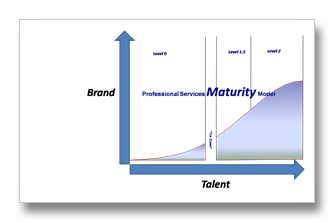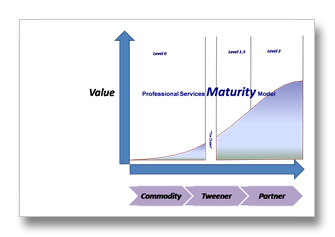Okay, so lets start diving into something meaningful.
As I began to create the PSMM, I first asked myself, "how would I accurately assess a Professional Services (PS) firm if I was going to buy it with my own money?". The reason I asked this question should be obvious: spending your own money makes you want to do it correctly.
I've participated in "due diligence" investigations when PS acquisitions were being considered, and trust me, I've seen the negative ramifications of not utilizing a framework. In fact, it is very common to hear about PS acquisitions that didn't work. Of course, there are many reasons for failed acquisitions, but the assessment of the acquisition target should absolutely be completed to ensure business model fit.
It became evident that a simple, yet powerful framework would be needed to assist in an assessment of a PS firm.
The next question I asked myself was "If we had a framework for an objective assessment, how could we use it to create a framework for maturity?"
Thus, the final goal during the creation of the PSMM was to provide meaningful and objective framework that would allow the professional services community at large to contribute best practices and new protocols for PS maturation. It then can become feasible to think that PS subtypes (Accounting, Law, IT Consulting, etc) could contribute their own protocols and best practices, but yet still be extendable and valuable beyond their subtype.
The framework presented in the PSMM doesn't or shouldn't replace any other business planning tool that your firm is using. (Although I've never seen any other tool actually provide any meaningful information in PS industry. Enough with the SWOT analysis already! How many years have gone by without making any significant strides towards Maturity??).
Below, in all of it's simple brilliance is the PSMM framework. It has 3 levels and a dangerous chasm.
We'll talk about the levels in a moment, but first, lets talk about context for axis definition.
PSMM Axis Definition
The PSMM framework is a simple framework, and we've learned that axis definition around the framework can accommodate multiple context view
Axis Context View #1
Starting with the most basic context: economics - clients will pay more from something that they value. Therefore, we can define the vertical axis as the fees you can bill for the services you are providing your client and the horizontal axis is the "strategic value" your client is receives from your services. It goes without saying that if your value is low, chances are your fees is going to be pretty low. Now that we are in the global economy, if your value is low, your services are at a commodity level.
Axis Context View #2
Another way to look at the axis definition is based upon your brand recognition (current or potential) and the level of talent you are able to recruit. I know what you are thinking, "money buys the talent". However, there are a number of studies that have demonstrated the correlation between brand and talent. Even though you have an argument, I would argue that not only will that line of thinking provide you with lower margins, the talent your are buying is a poor investment for your firm. We'll talk more about investments and talent in subsequent posts. You may also be thinking that "Everyone already knows my company". I would refer back to the post that discusses Truth and Anguish.
Axis Context View #3
Here is a context view that PS firms "who get it" should understand. On the vertical axis is "Client Trust" on the horizontal axis is "Ability to Influence". Those of us who have been successful in the consulting industry continue to work towards achieving high levels of both. The reason for which is measured in our ability to continue to recognize significant revenue streams from our clients.
Axis Context View #4
I tend to really like this view of the axis context because the term "partner" is such an overused word in our industry. I find it particularly amusing when low-value firms use this term openly to self-classify their value to clients.
Now, we can now use the PSMM framework for properly classifying a PS firm's value to clients. Looking at the framework then, we can classify A PS firm then can either be a "Commodity", "Tweener", or "Partner" based upon the value they provide to their client. We'll further define these classifications in future posts.
PSMM Maturity Levels
You see the curve, so lets define the levels.
Let me start off by saying that the classification of "Level 0" is not about a firms ability to make money. Rather, it's simply about maturity. It isn't meant to be an insult in any way. There are plenty of staff-augmentation companies that make good money. However, Level 0 is the easiest type of PS firm to create and run. You can make reasonable money, but if you are a publicly traded company, not only will Wall Street classify you as Level 0, they will also classify you as a "Commodity".
Believe it or not, I've heard executives from billion dollar plus PS firms (who will remain nameless) define their business model as "cheeks in seats", meaning, their whole goal is to provide as many resources as possible to fill the staff augmentation demands of their clients. The point to take out of this is that this is a "billion dollar" firm who makes a ton of money at the lowest level of maturity.
| Level of Maturity | Brief Definition |
| Level 0: "Staff Augmentation" | The lowest level of maturity. Firms in this category typically just provide resources to fill demand of their clients. The only strength of these firms is their ability to recruit Contract Personnel to perform the work as prescribed and managed by their clients. They typically act as a recruiting and payroll service for their clients. We would classify the talent in this category as "Contract Personnel" as opposed to "Consultants". The Staff Augmentation firm has relatively low legal or monetary risk in this category. |
| Level 1: "The Chasm" | Though the name could make you think otherwise, the Chasm is an actual level of maturity. While any forward movement on the maturity curve is difficult, it is most difficult (and the most expensive) to move between Level 0 and Level 1.5. This level is fraught with peril and should be taken very seriously. The protocol packs are going to be very important for you to survive this level. It is typical for firms in the Chasm to be performing their typical staff augmentation services, but their attention is given to figure out how to go "Project Shopping". |
| Level 1.5: "Project Shopping" | As a firm emerges from the Chasm, the next evolution in the maturity framework is to go "project shopping". Project Shopping can be defined as looking for business (RFP or other) that is a natural fit for the capability that is emerging. Typically what we see in the initial stages of "Project Shopping" is firms continuing their staff augmentation business while shopping (looking) for RFP business that is a natural fit for their capability. The primary benefit for firms in this category is now they has some number of resources who are skilled at something. Methodologies are non existent or just emerging In the early stages. Later in the stage, the methodologies are more complete as they are updated or tweaked over the course of engagements. The primary value of firms in this stage is "now they resources with some specific capability". These firms are beginning to take on serious legal risk. |
| Level 2.0: "Solutions Partner" | This is the "Partner Level" so sought after by so many firms. I keep repeating this, but it's important. The majority of firms will misrepresent themselves and call themselves "Solutions Partners" or "Partners". If you are a client, you really, really need to understand this. The fact remains that few firms mature to this level. The best way to define this level is "having the capability to help clients achieve their business goals time after time". Methodologies are very mature proven and fine tuned over many engagements. We will typically see the highest levels of talent working for firms at this level of the maturity model. We will also see these firms as the most confident in their ability to take on work as the risk at this level is the highest possible. |










No comments:
Post a Comment